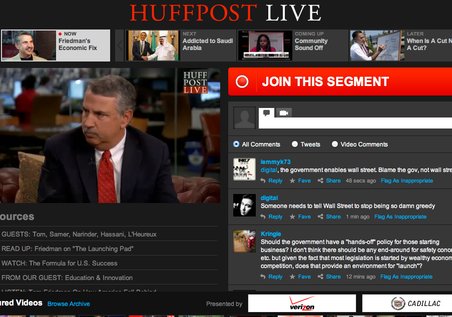Content Marketing
HuffPost Live and BuzzFeed Radio Bring New Twist to Traditional Media
Internet companies BuzzFeed and Huffington Post announced two new ventures last week. The new forays were not new blog verticals or staff changes but the debut of two new revolutionary formats: a radio station and a television network.
BuzzFeed Radio, a live, weekly, call-in show on SiriusXM has BuzzFeed editors Jack Moore (@BuzzFeedJack) and Whitney Jefferson (@twitney) “dissect, discuss and offer a behind-the-scenes look at the inspiration, reaction and creative process behind the week’s biggest viral sensations” according to a press release on BuzzFeed.
BuzzFeed Radio airs live on Tuesdays at 6:00 pm EST and played again Wednesday mornings and evenings on SiriusXM Stars Too (channel 104).
HuffPost Live is Huffington Post’s new “never-ending news talk show on the Internet,” streaming 12 hours of programming daily.
BuzzMedia’s launch of BuzzFeed Radio, acquisition of Spin Magazine (soon to be no longer), and political bureau in D.C., and Huffington Post’s new HuffPost Live, and weekly magazine Huffington, the evolution of Internet companies becoming media networks is an ironic twist on the state of media overall.
While traditional networks are competing to capture audience’s attention with digital, both Internet-based blogs are looking into new mediums to reach audiences beyond online editorial.
BuzzFeed’s penchant for creating viral content combined with their active online community allows for an easy transition to online radio. Sirius has had a history of unique programming and looking to social platforms was a “natural progression” says Scott Greenstein, chief content officer at the satellite-radio company to Advertising Age.
BuzzFeed Radio allows the platform to reach current audiences offline and Sirius’ 22 million subscribers.
BuzzFeed Managing Editor Scott Lamb explains, “We’re on your computer screens at work and now we’re taking over your cars on the way home. The way you react to and share a BuzzFeed story with your friends is the same emotional reaction someone has when they call into the radio. Our commenters are like radio’s callers so working with SiriusXM just feels really organic.”
 Ad Age’s Jason Del Ray calls HuffPost Live “bold” and “a TV news experience for the digital age.”
Ad Age’s Jason Del Ray calls HuffPost Live “bold” and “a TV news experience for the digital age.”
The show debuted with a few technical difficulties and mixed reactions. Last week most of the programming featured interviews with community commentary in real time. Hosts play a multi-functional role on HuffPost Live as part community moderators and managers, trained to display tweets at any second.
President Roy Sekoff tells Advertising Age his approach is “iterative on purpose,” experimenting with multiple formats. The inconsistency and focus on community commentary had Brian Stelter from New York Times say HuffPost Live was more chatter than reporting.
While “the network will feature The Huffington Post’s writers and editors…it will not have is traditional reporters in the field, preferring mostly to talk about the news rather than gather it independently,” he wrote. “Talking tends to be cheaper than reporting.”
While one might argue that an online television network is appropriate for the digital age, BuzzFeed Radio has the best and most strategic choice. Producing video programming is far more ambitious and expensive to produce and radio is a medium that follows audiences to their offline activities.
BuzzFeed Radio will be about BuzzFeed’s process on developing original content, while HuffPost Live is a regurgitation of what everyone else is saying.
Get better at your job right now.
Read our monthly newsletter to master content marketing. It’s made for marketers, creators, and everyone in between.





